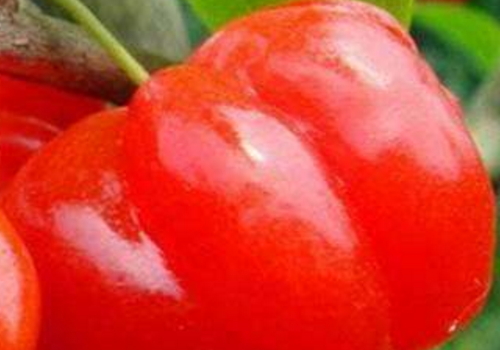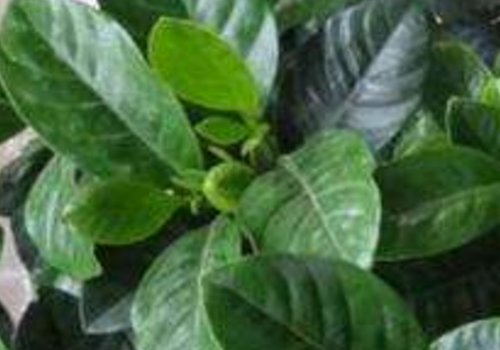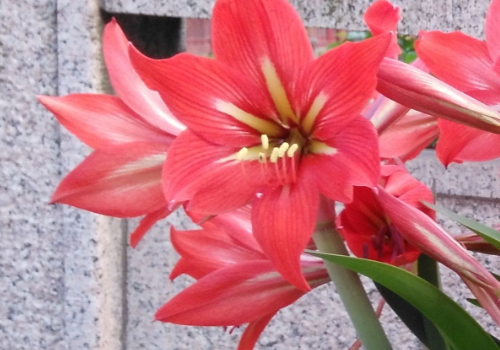How to plant red fruit bonsai and how to reproduce
Red fruit is relatively rare, but some people like to plant it. How to grow red fruit bonsai? How do you breed?
How to grow red fruit bonsai:
1. Soil: potted red fruit can be mixed with 5 parts of humus soil, 3 parts of garden soil and 2 parts of sandy soil, and mixed with a small amount of phosphorus and potassium fertilizer such as calcium superphosphate and bone powder.
2. Fertilization: although Hongguo likes fertilizer, it does not like thick fertilizer. It should be applied frequently with thin fertilizer. It can be applied once every 10 to 15 days. Nitrogen fertilizer is the main fertilizer in young trees or shoot stage, and compound fertilizer is mainly applied in other periods.
3. Lighting: red fruits should be kept outside in the sun and air during the growing season, and should be properly shaded and protected from the hot sun in summer.
4. Watering: red fruit is watered frequently during the growing period, do not dry the basin soil, and often spray water to the plant and the surrounding environment to increase air humidity.
5. Pruning: red fruit is resistant to pruning and can be pruned according to different tree types. Useless buds can be erased at any time during the growing period and coring at the right time to keep the plant type perfect.

How do red fruit bonsai breed:
1. Sowing: red fruit is suitable for sowing in spring and autumn. The seeds were taken out and washed, buried shallowly in loose soil, and germinated in about 3 weeks. After about 1 year, the seedlings were retransplanted with a height of more than 15 cm.
2. Ramet: young plants growing from the rhizosphere of the mother plant can often be found on the ground near the plant, and they can also be excavated and planted, but the fine roots of the red fruit are very few, so we should pay special attention to digging deeply when transplanting, so as to avoid cutting off the roots as far as possible, so as not to affect the survival rate of transplantation.
All right, this is the end of the introduction to the bonsai planting method of red fruit, all of you understand.
Bonsai cultivation techniques of Red Fruit (Brazilian Red Fruit) Chinese scientific name: red fruit Latin name: Eugenia uniflora alias: Brazilian red fruit kingdom: plant boundary: angiosperm subphylum: angiosperm subphylum: dicotyledon: myrtle: myrtle genus: cherry species: red fruit distribution area: Brazil The red fruit of southern China (EugeniaunifloraL.), also known as Prunus cherry and Bidang eggplant, has a beautiful tree shape, dark green leaves and evergreen all the year round. The fruit has peculiar shape, beautiful color and delicious taste, so it is an excellent flower and tree suitable for ornamental and edible purposes, which is worth popularizing. Potted red fruit is suitable for growing in slightly acidic sandy soil with rich humus, loose and fertile soil and good air permeability. The pot culture can be mixed with 5 parts of humus soil, 3 parts of garden soil and 2 parts of sandy soil, and mixed with a small amount of phosphorus and potassium fertilizer such as calcium superphosphate and bone powder. The growing season should be maintained in an outdoor place with sufficient sunshine and air circulation, and appropriate shading to prevent hot sun exposure in summer; watering frequently during the growing period, do not dry the basin soil, and often spray water to the plant and the surrounding environment to increase air humidity. Although Hongguo Zai likes fertilizer, it does not like thick fertilizer. Thin fertilizer should be applied frequently, and mature dilute liquid fertilizer can be applied every 10 to 15 days. Nitrogen fertilizer is the main fertilizer in young trees or shoot stage, and compound fertilizer is mainly applied in other periods. Move into the room in winter, control watering, more than 5 ℃ can safely survive the winter. Red fruit is resistant to pruning and can be pruned according to different tree types. Useless buds can be erased at any time during the growing period and coring at the right time to keep the plant type perfect. Change the pot once every 2 years or so in spring. When changing the basin, remove the old soil of 2Accord 3, cut off the overlong old root, and then plant it with the new culture soil. August is the flower bud differentiation period of red fruit, so we should properly control watering and increase the application of phosphorus and potassium fertilizer, and there will be buds in October. Pay attention to heat preservation in winter, the temperature should not be lower than 10 ℃. At the beginning of December, some old leaves fell off and blossomed one after another. Flowering period watering do not pour water on the flowers, outdoor planting in the south should also pay attention to rain, so as not to cause falling flowers. Since the florescence is in winter, no insects can pollinate, so artificial pollination can be carried out every morning to increase the amount of fruit. Red fruit has the habit of blooming and fruiting at the same time. In order to make the fruit size uniform, keep the same batch of fruit as far as possible. When the fruit reaches the required number, the remaining buds can be cut off and the small fruit, weak fruit and over-dense fruit can be removed so that the size of the fruit is uniform. When the fruit is stable, the amount of phosphorus and potassium fertilizer should be increased, and 0.2% potassium dihydrogen phosphate solution can be sprayed every 7 days or so. From R2 to March, the fruit is ripe, which is the best viewing period for red fruit. If the winter temperature is low, the florescence of red fruit will be postponed to February to March of the following year, and the fruit will not mature until May to June. After the viewing period, the residual fruit is removed, the plant is re-cut, the thin and weak branches and diseased branches are cut off, the overlong branches are cut short, and the water and fertilizer management is strengthened after pruning, and new buds will grow in about 20 days. When the new buds grow to 15~20cm, the branches that sprout again after coring, except for keeping 315 ~ 5 ~ I-as "sacrificial branches" to allow them to grow, the other branches remove the top buds to promote the autumn buds to be short and thin, to form flower branches, so as to achieve the purpose of more flowering and fruiting. When the old leaves mature at the end of November, the "sacrificial branches" will be cut off when the nutrition shrinks. > Propagation and sowing: the seeds can be taken after the fruit is ripe, sowed with picking, keep the soil moist after sowing, emerge in about 40 days, and transplant in the spring of the following year. Root cutting: it can be combined with changing pots in spring to cut off the sturdy thick roots and has a high survival rate. The culture method of red fruit seed
The culture method of red fruit seed
The basic information of Hongguo
Scientific name: Eugenia uniflora
Alias: Corner peach, almond, tomato, Brazilian red fruit, bidang eggplant.
Families and genera: myrtle family, myrtle genus.
Semi-evergreen or evergreen shrubs or small trees, up to 4-5 m tall. The branches are soft and drooping. Leaves opposite, ovate to elliptic, apex acuminate, 2.5-3.5 cm long, entire, dark green, abaxially gray-white, surface veins obviously concave, petiole short. Flowering and fruiting from summer to autumn, with slender peduncles, small, white, fragrant flowers, single or 2-5 Cymes in leaf axils. The fruit stalk is long, the berry is flat and globular, 1.5 cm in diameter, with 8 longitudinal edges, initially light green, then yellow to orange-red, bright red when ripe, edible. Seeds yellowish white, oblate.
The leaves of red fruits are green, the new young leaves are brown and red, and they have bloomed continuously since the Summer Solstice's autumn. There are often not only flowers but also green, yellow, orange-red and red berries on a plant. Its fruit hangs in the branches and leaves, like countless small red lanterns dotted with rich colors, crystal and lovely. It is an excellent flower species with good foliage and fruit appreciation. Because of the resistance to pruning, the branches are Qiu qu, and the stump bonsai can also be made.
[red fruit propagation] sowing, ramet, cutting.
The main results are as follows: (1) sowing: after the seeds are mature in spring and autumn, the germination ability of the seeds can be maintained for about 30 days. Keep the seedbed moist after sowing and germinate after 20-40 days. It can bear fruit after 3 or 4 years of cultivation.
(2) ramet: adult plants often sprout young plants in the rhizosphere, which can be dug up and planted separately.
(3) Cuttage: the root cutting method can be used, usually combined with turning the basin in spring. Cutting cuttings with sturdy thick roots growing about 10 cm, the survival rate is very high.
[key points of red fruit cultivation]
(1) temperature: like high temperature weather, the most suitable temperature for growth is 23 °C to 30 °C. Has a certain cold resistance, can withstand a short-term low temperature of-3 ℃ / 2 °C. However, it is best to keep the temperature above 5 °C in winter, and fallen leaves will occur when the temperature is low. If the temperature is kept above 10 °C in winter, although some of the old leaves will fall off in early December, they can continue to blossom.
(2) Illumination: it requires no light, likes sufficient sunlight, is tolerant to half-shade, and can grow normally under the condition of full sunlight and half-shade. But the summer high temperature needs proper shade to prevent the hot sun exposure.
(3) watering: like humid environmental conditions, not resistant to drought. Water should be fully watered during the growth period, especially when the high temperature is intense in summer, more attention should be paid to the supply of water. But avoid drainage is not smooth. During the period of flower bud differentiation, water should be saved properly to promote flower bud differentiation. When watering, avoid pouring water on the flowers; when planting outdoors, you should pay attention to rain protection, so as not to cause flowers to fall. The drip should be controlled in winter to keep the basin soil relatively dry. If the plants with high temperature in winter continue to grow and blossom, they should be watered normally.
(4) Environmental humidity: like the humid environment, the growing season should often spray water to the branches and leaves and the surrounding environment, in order to increase environmental humidity.
(5) fertilization: do not tolerate barren, like fertilizer, but do not like thick fertilizer, fertilization should grasp the principle of "thin fertilizer and diligent application". Fertilizers, young trees and young trees are topdressing every 10 to 15 days.
Nitrogen fertilizer is the main fertilizer in the stage of branching and leafing, and phosphorus and potassium fertilizer should be applied after entering the flower bud differentiation stage to promote flower bud differentiation and flowering and fruiting. When the results are stable, 0.2% potassium dihydrogen phosphate solution should be sprayed left and right every 7 days, which is beneficial to the growth and beautiful coloring of the fruit.
(6) pruning: resistant to pruning. After the viewing period, the residual fruit should be picked and the plant should be re-cut once. In addition to cutting off thin and weak branches, over-dense branches and branches of diseases and insect pests, it is also necessary to cut short the long branches left behind to restore the plant to good growth. It is necessary to strengthen the management of fat pipes after pruning, and new buds will grow in about 20 days. When the new bud grows to 15-20 cm, it is necessary to pick the heart once, and then pick the heart again after the side branch is long, in order to control the length of the branch and form flower buds, so as to achieve the purpose of multi-flowering, multi-fruit and maintain a good tree shape. Because of the habit of blooming while bearing fruit, # should keep the same batch of fruit as far as possible in order to make the size of the fruit uniform. When the fruit reaches a certain number, the later formed buds should be cut off, and the small fruit and overdense fruit should be removed. The plant can also be trimmed into circular, tapered and other shapes. 'To
(7) go up and turn the pot: it is appropriate to use a larger pot for potted plants. Because the root is taproot and the fine root is very few, attention should be paid not to damage the root system when transplanting into the basin. Plants with exuberant growth should be turned into pots every 2 years. When turning the basin, get rid of the old soil of 2 bank 3 and cut off the over-long old roots. Like the slightly acidic sandy soil rich in humus, loose and fertile, and good air permeability, the matrix can be prepared with rotten leaf soil, garden soil, peat soil and coarse sand, and mixed with a small amount of calcium superphosphate, bone powder and other phosphorus and potassium fertilizer as base fertilizer.
(8) artificial pollination: if flowering in winter, because there are no insects to pollinate, artificial pollination should be carried out every morning to increase fruit.
(9) Prevention and control of diseases and insect pests: there are few diseases and insect pests, but sometimes anthrax and shell insects, beetle adults, butterfly larvae and other diseases and insect pests.
[common problems in planting and raising red fruits]
The causes of common problems are low temperature of ① for deciduous leaves, too dry or too wet for ② pot soil, low temperature for ① with concentrated fertilizer for falling flowers, too dry or too wet for ② pot soil, less rain for ⑤ watering or blooming, low light for ①, simple application of nitrogen fertilizer at flower bud differentiation stage for ②, no coring at early growth stage for ⑤, and no artificial assisted pollination for ④.
- Prev

Can gardenia be cultured in water? how can it be cultured in water?
Gardenia, which is a plant that many people like, is very beautiful. Can gardenia be hydroponically cultivated? How to cultivate in hydroponics? Gardenia can be hydroponically cultured: gardenia can be hydroponically cultured, gardenia likes warm, moist, well-ventilated and well-ventilated environment, avoid strong light exposure. Gardenia is suitable for living in a slightly shaded place and is resistant to semi-shade.
- Next

What is the red flower language of Zhu Dinghong? how to reproduce?
Zhu Dinghong, this is a common plant, but many people don't know its name. What is the red flower language of Zhu Ding Hong? How do you breed? What is Zhu Dinghong flower language: Zhu Dinghong is a relatively fragile bulb plant. Growing Zhu Dinghong in Britain must be covered with a protective cover against cold damage, and the sunshine should be adequate.
Related
- Fuxing push coffee new agricultural production and marketing class: lack of small-scale processing plants
- Jujube rice field leisure farm deep ploughing Yilan for five years to create a space for organic food and play
- Nongyu Farm-A trial of organic papaya for brave women with advanced technology
- Four points for attention in the prevention and control of diseases and insect pests of edible fungi
- How to add nutrient solution to Edible Fungi
- Is there any good way to control edible fungus mites?
- Open Inoculation Technology of Edible Fungi
- Is there any clever way to use fertilizer for edible fungus in winter?
- What agents are used to kill the pathogens of edible fungi in the mushroom shed?
- Rapid drying of Edible Fungi

